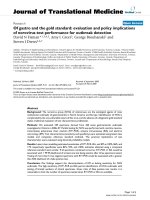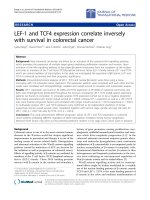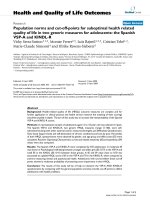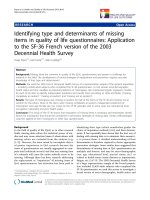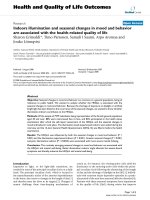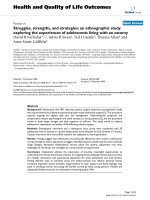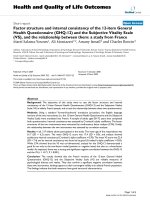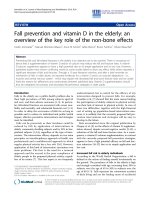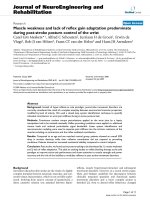báo cáo hóa học:" Of gastro and the gold standard: evaluation and policy implications of norovirus test performance for outbreak detection" ppt
Bạn đang xem bản rút gọn của tài liệu. Xem và tải ngay bản đầy đủ của tài liệu tại đây (454.13 KB, 9 trang )
BioMed Central
Page 1 of 9
(page number not for citation purposes)
Journal of Translational Medicine
Open Access
Research
Of gastro and the gold standard: evaluation and policy implications
of norovirus test performance for outbreak detection
David N Fisman*
1,3,4,5
, Amy L Greer
3
, George Brouhanski
2
and
Steven J Drews
2,6,7
Address:
1
Division of Epidemiology and Surveillance, Ontario Agency for Health Protection and Promotion, Toronto, Canada,
2
Ontario Public
Health Laboratories, Ontario Agency for Health Protection and Promotion, Toronto, Canada,
3
Child Health Evaluative Sciences, Research Institute
of the Hospital for Sick Children, Toronto, Canada,
4
Department of Health Policy, Management and Evaluation, University of Toronto, Toronto,
Canada,
5
Department of Epidemiology, Dalla Lana School of Public Health, University of Toronto, Toronto, Canada,
6
Department of
Pathobiology and Laboratory Medicine, University of Toronto, Toronto, Canada and
7
Department of Microbiology, Mount Sinai Hospital,
Toronto, Canada
Email: David N Fisman* - ; Amy L Greer - ;
George Brouhanski - ; Steven J Drews -
* Corresponding author
Abstract
Background: The norovirus group (NVG) of caliciviruses are the etiological agents of most
institutional outbreaks of gastroenteritis in North America and Europe. Identification of NVG is
complicated by the non-culturable nature of this virus, and the absence of a diagnostic gold standard
makes traditional evaluation of test characteristics problematic.
Methods: We evaluated 189 specimens derived from 440 acute gastroenteritis outbreaks
investigated in Ontario in 2006–07. Parallel testing for NVG was performed with real-time reverse-
transcriptase polymerase chain reaction (RT
2
-PCR), enzyme immunoassay (EIA) and electron
microscopy (EM). Test characteristics (sensitivity and specificity) were estimated using latent class
models and composite reference standard methods. The practical implications of test
characteristics were evaluated using binomial probability models.
Results: Latent class modelling estimated sensitivities of RT
2
-PCR, EIA, and EM as 100%, 86%, and
17% respectively; specificities were 84%, 92%, and 100%; estimates obtained using a composite
reference standard were similar. If all specimens contained norovirus, RT
2
-PCR or EIA would be
associated with > 99.9% likelihood of at least one test being positive after three specimens tested.
Testing of more than 5 true negative specimens with RT
2
-PCR would be associated with a greater
than 50% likelihood of a false positive test.
Conclusion: Our findings support the characterization of EM as lacking sensitivity for NVG
outbreaks. The high sensitivity of RT
2
-PCR and EIA permit identification of NVG outbreaks with
testing of limited numbers of clinical specimens. Given risks of false positive test results, it is
reasonable to limit the number of specimens tested when RT
2
-PCR or EIA are available.
Published: 26 March 2009
Journal of Translational Medicine 2009, 7:23 doi:10.1186/1479-5876-7-23
Received: 6 September 2008
Accepted: 26 March 2009
This article is available from: />© 2009 Fisman et al; licensee BioMed Central Ltd.
This is an Open Access article distributed under the terms of the Creative Commons Attribution License ( />),
which permits unrestricted use, distribution, and reproduction in any medium, provided the original work is properly cited.
Journal of Translational Medicine 2009, 7:23 />Page 2 of 9
(page number not for citation purposes)
Background
Outbreaks of acute gastroenteritis (AGE) are a common
cause of morbidity, and even mortality, in institutional
and community settings in Canada and the United States
[1,2]. Gastrointestinal disease outbreaks (defined by John
Last as "epidemic [s] limited to localized increase in the
incidence of a disease [3]") are most commonly caused by
the norovirus group of caliciviruses (NVG) in North
America and Europe; this may be due to both extremely
high infectivity and prolonged environmental survival of
these agents [1]. Although control of norovirus-related
AGE outbreaks depends on measures that may be some-
what independent of microbial etiology (e.g., environ-
mental disinfection, cohorting or isolation of infectious
individuals, enhanced hand hygiene, etc.) positive identi-
fication of NVG as the etiology of an outbreak may con-
tribute to the understanding of the burden and
epidemiology of these infections, pinpoint the outbreak
source, and rule out other AGE etiologies which may be
managed differently.
The identification of NVG as the etiologic agents of AGE is
complicated by the non-culturable nature of these viruses.
Identification of NVG has traditionally depended on dem-
onstration of characteristic viral particles in clinical speci-
mens using electron microscopy (EM). However, EM is
expensive, time consuming, and appears insensitive [4,5].
The availability of rapid, highly sensitive testing method-
ologies would constitute an important advance in the
identification and management of norovirus-associated
AGE outbreaks.
Both polymerase chain reaction (PCR) and enzyme
immunoassay (EIA) methods have been developed for the
detection of norovirus infections caused by both geno-
group 1 (G1) and 2 (G2) strains. These assays have uti-
lized in a variety of geographic settings and in the context
of both outbreak investigation and in the evaluation of
sporadic cases of gastrointestinal illness [6-9]. However,
as is the case with other non-culturable or culturable but
fastidious pathogens, the assessment of the performance
of these tests is complicated by the absence of a referent
"gold standard". While EM is thought to be a highly spe-
cific diagnostic modality, it lacks sensitivity; molecular or
immune-based test modalities may exceed EM in sensitiv-
ity but may lack specificity.
The issue of "tarnished" or absent gold standards for
molecular diagnostic tests has emerged as an important
issue in the era of molecular diagnosis [10]. Such method-
ological approaches to resolution of test result discord-
ance as "discrepant analysis" (performing additional tests
for specimens that yield conflicting test results) produce
biased estimates of test performance [10]. Alternate meth-
ods, such as "latent class models" (LCM), and the use of
"composite reference standards" (CRS), have emerged as
preferred means for evaluating test characteristics (i.e.,
sensitivity and specificity) when gold standard tests are
absent [11,12]. The former represents a mathematical
method for estimating the probability that an individual
specimen with a given constellation of test results has a
true, unobservable (or latent) status of "positive" or "neg-
ative", based on the assumption that the observed constel-
lation of test results is that which would be most likely for
the estimated prevalence of truly positive specimens and
test sensitivities and specificities.
The latter method (CRS) utilizes constellations of results
of imperfect results (e.g., a positive result of a single highly
specific test and/or positive results of multiple sensitive
but less specific tests) as a proxy for a gold standard test;
this approach should provide unbiased estimates of test
characteristics for, as stated by Pepe, "the definition of dis-
ease is not dependent on the results of the diagnostic test
under investigation [11]." Our objectives were (i) to eval-
uate the test performance for real-time reverse-tran-
scriptase (RT
2
-) PCR, EM, and EIA for norovirus using
both LCM and CRS; and (ii) to evaluate the implications
of these characteristics for outbreak testing practices.
Methods
Laboratory Methods
We obtained data on all NVG testing by the Ontario Cen-
tral Public Health Laboratory (CPHL) through the
autumn, winter and spring of 2006–2007. The CPHL pro-
vides all diagnostic services for institutional and commu-
nity outbreak investigations that included both vomiting
and diarrhoea in Central Ontario. Prior to August 2006,
all NVG testing at the CPHL was performed using electron
microscopy (EM); in August 2006, the laboratory intro-
duced RT
2
-PCR for identification of NVG. All specimens
underwent parallel testing with electron microscopy and
RT
2
-PCR. Stool specimens were prepared for EM using the
direct method without concentration, with phosphotung-
stic acid staining. EM was undertaken with either a Philips
CM10 or FEI Morgagni 268D transmission electron
microscope. For the purposes of this study, a non-system-
atically selected subset of 189 isolates was also subjected
to testing using the commercially available Oxoid™
enzyme immunoassay (EIA) (up to 2 specimens per out-
break).
All testing was performed on stool homogenates prepared
in double distilled water. RNA for RT
2
-PCR was obtained
through automated extraction of clarified supernatants
using a Biorobot MDX (Qiagen). Details of primers and
probes utilized for RT
2
-PCR are appended [see Additional
file 1] [13-15]. RT
2
-PCR was performed on the ABI 7900
SDS instrument using the following conditions: (i) reverse
transcriptase for 30 min at 50°C, (ii) 15 min at 95°C to
Journal of Translational Medicine 2009, 7:23 />Page 3 of 9
(page number not for citation purposes)
activate Taq polymerase, and (iii) 45 cycles of 15 s at
95°C, and 60 s at 60°C; fluorescent signal collection with
a fluorogenic TaqMan probe was done at annealing/exten-
sion step, with duplex evaluation of G1 and G2 ampli-
cons. To obtain quantitative controls, G1 and G2
amplicons from archived strains were cloned into pCR4-
TOPO, linearized and sequenced using the ABI Genetic
Analyzer 3100. MS2 RNA from MS2 phage (0.8 μg/μl, 100
copy/μl) (Roche) was used as an internal RT
2
-PCR control
[16,17]. Negative controls included a non-template con-
trol for extraction and a PCR-negative control (distilled
water). The assay uses a cycle time cutoff of 35 cycles or
less to define positivity.
The RT
2
-PCR assay was evaluated for a year, and trialed in
our laboratory for an additional year, before being inte-
grated into the laboratory's clinical testing repertoire. The
assay was validated using both in-house specimens char-
acterized through a combination of EM, RT
2
-PCR, and
sequence analysis, and also using norovirus-containing
specimens and negative controls provided in a blinded
fashion by other collaborator sites. This protocol has been
subjected to a continuous external quality assurance pro-
gram over the past three years. Additional details related
to the laboratory's RT
2
-PCR protocol may be obtained via
correspondence with the authors.
Evaluation of Test Characteristics
Test characteristics of RT
2
-PCR, EIA, and EM were evalu-
ated using latent class models (LCM) and composite ref-
erence standard (CRS) methods. LCM represent a
likelihood-based, iterative class of models that assign an
unobservable, or "latent" status to each individual in a
population based on the observed constellation of test
results, and co-variation of positive and negative test
results, in the population under study. With reference to
diagnostic testing, the "latent class" of interest is the true
disease status of the source patient. As with many tools
used for statistical inference, a key assumption in latent
class analyses is the conditional independence of test
results [11,12]. Latent class analysis was performed using
the PROC LCA command created by The Methodology
Center at the Pennsylvania State University [18], and
implemented in SAS (version 9.1, SAS Institute, Cary,
NC).
We also evaluated test characteristics relative to a CRS,
which was defined as "test positive" if either electron
microscopy, or both EIA and RT
2
-PCR were positive. As
such CRS do not require additional testing of specimens
based on discrepant results, they are not subject to the
type of verification bias present in discrepant analysis
[11]. CRS may also provide an unbiased estimate of test
characteristics under the assumption of conditional inde-
pendence of test results [11,12].
As parametric estimation of confidence intervals is com-
plex for LCA [19], we estimated 95% credible intervals for
both LCA and CRS estimates using bootstrap resampling
based on a binomial distribution of test results and prev-
alence, with 10,000 realizations performed for sensitivity
and specificity of each test, and for population prevalence
of infection. Combined test characteristic estimates and
prevalence for each realization were used to estimate cred-
ible intervals for predictive values.
Implications for Laboratory Practice
We evaluated the implications for testing practice of test
characteristic estimates, based on the assumption that that
testing results would follow a binomial ("coin toss") dis-
tribution. For a given test sensitivity, we calculated the
number of truly positive specimens that would need to be
tested using each testing method, in order to have at least
one test positive with greater than 99% certainty. For a
given specificity, we calculated the number of truly nega-
tive specimens that would need to be tested in order to
have a > 50% chance of false positive identification of
NVG.
In practice, it is likely that not all specimens submitted
from a true NVG outbreak actually contain NVG. We eval-
uated the number of sequential tests necessary for identi-
fication of a NVG outbreak using Kaplan-Meier methods
[20], by organizing test submissions in order of accession,
and using cumulative specimen count as the "time" varia-
ble in these calculations. We also calculated the propor-
tion of specimens testing positive for NVG by RT
2
-PCR in
all outbreaks, and in outbreaks with or without EM con-
firmation. These proportions were used to approximate
the proportion of positive specimens among specimens
submitted in a true outbreak, and this proportion was in
turn used to estimate the number of tests that need to be
performed on a mixed (true positive and true negative)
sample of specimens in order to identify an outbreak, for
a given degree of test sensitivity.
Serial negative testing could either represent a true
absence NVG in tested specimens, or of failure of a test to
identify a truly positive specimen. The upper confidence
limit (for a given type I error, α) for the probability of an
event (π) when zero outcomes are observed after n trials
[21] is:
UCL(π) = 1-α
1/n
(1.0)
In the context of testing, π is the probability that a test is
positive, P(T+), either truly or falsely. Thus the upper
bound estimate for P(T+) is the right-hand side of equa-
tion (1.0). We denote this probability as P
u
(T+). The prob-
ability of a positive test can be written as a function of test
Journal of Translational Medicine 2009, 7:23 />Page 4 of 9
(page number not for citation purposes)
characteristics and specimen status (true positive (D+) or
true negative (D-)):
P
u
(T+) = P(T+|D+) × P
u
(D+) + P(T+|D-) × (1-P
u
(D+))
(1.1)
Which can be rewritten in terms of sensitivity, specificity,
and upper bound prevalence of NVG (P
u
(NVG)) among
specimens:
P(T+) = (sensitivity) × P
u
(NVG) + (1-specificity) × (1-
P
u
(NVG)) (1.2)
Since test sensitivity and specificity are known, it is possi-
ble to solve for the upper bound for prevalence of NVG
among submitted specimens, in the face of a series of neg-
ative tests [21] by rearranging equation (1.2):
P
u
(NVG) = (UCL(π)-1+specificity)/(sensitivity+specifi-
city-1) (1.3)
Equation 1.3 yields plausible values for UCL(π) > 1 – spe-
cificity, UCL(π) < sensitivity, and (specificity + sensitivity
> 1).
Results
A total of 440 gastrointestinal disease outbreak investiga-
tions were performed during the study period, 93% of
which occurred between November '06 and March '07.
The median number of specimens submitted per outbreak
was 2, with a range of 1 to 26. Three hundred and twenty-
four outbreaks (73.7%) were associated with one or more
specimen testing positive for NVG by EM (0.6%), RT
2
-
PCR (64%) or both (35%). Norovirus outbreak character-
istics are further described in Table 1.
One-hundred and eighty nine specimens from outbreaks
were non-systematically selected for further characteriza-
tion and evaluation by EIA. Of these specimens, 95
(50.3%) were positive by RT
2
-PCR, 74 (39.1%) were pos-
itive by EIA, and 14 (7.5%) were positive by EM. Three
specimens yielded equivocal results by EIA; for the pur-
poses of subsequent analyses these test results were con-
sidered to be negative. Of 95 RT
2
-PCR-positive specimens,
87 (91.6%) were from genogroup G2. Estimated test char-
acteristics, based on LCM, and on comparison with CRS,
are presented in Table 2. RT
2
-PCR was assigned the high-
est sensitivity with both methods, but had lower specifi-
city; EM was estimated to be insensitive but perfectly
specific. The characteristics of EIA were intermediate
between those of RT
2
-PCR and EM.
Based on the test characteristics presented in Table 2, it is
possible to estimate the mean number of tests required, in
the presence of positive specimens, to have at least one
true positive result, and the mean number of tests per-
formed on negative specimens in order to have at least
one false positive result. These calculations are presented
in Figures 1A and 1B. If all submitted specimens con-
tained NVG, RT
2-
PCR or EIA would be associated with >
99.9% likelihood of at least one test being positive after
three specimens tested. By contrast, even if all specimens
actually contained norovirus, EM would require seven
specimen submissions for the likelihood of identification
to exceed 80%, and 12 specimens for the likelihood of
identification to exceed 90%.
Table 1: Characteristics of Norovirus Outbreaks
Outbreak Characteristic (N = 324) Number (% or Range)
Median Specimens Submitted per Outbreak 2 (1 to 26)
Outbreak Identification
PCR only 209 (64.5)
EM only 2 (0.6)
EM and RT
2
-PCR 113 (34.9)
Outbreak Locale or Institution Type
Long-term Care or Skilled Nursing Facility 177 (54.6)
Healthcare Facility 30 (9.3)
Daycare or Preschool 14 (4.3)
Restaurant or Hospitality Industry 8 (2.5)
Family or Private Home 4 (1.2)
Unspecified 89 (27.6)
Location
Greater Toronto Area (Toronto, Durham, Halton, Peel and York) 123 (38.0)
Ottawa 51 (15.7)
Hamilton-Niagara 55 (17.0)
RT
2
-PCR, real-time reverse-transcriptase polymerase chain reaction; EM, electron microscopy.
Journal of Translational Medicine 2009, 7:23 />Page 5 of 9
(page number not for citation purposes)
Conversely, given estimates of specificity, repeated testing
of negative specimens by either RT
2
-PCR or EIA would be
likely to produce false positive results. With RT
2
-PCR, test-
ing of more than 5 negative specimens would be associ-
ated with a greater than 50% likelihood that at least one
specimen would yield a falsely positive result; the likeli-
hood of at least one false positive test if an equal number
of specimens were tested using EIA would be 20 to 30 per-
cent, depending on whether one used the specificity esti-
mate derived from LCM or the CRS (Figure 1B).
Specimens submitted for evaluation in the context of out-
break investigations are likely to contain a mixture of truly
positive and truly negative specimens; in this context, we
used Kaplan-Meier methods to evaluate the relationship
between specimen submissions and the identification of
at least one positive specimen in PCR-positive outbreaks
with and without EM confirmation. Even with a test with
approximately 100% sensitivity (i.e., PCR) and in the con-
text of a true-positive (EM-confirmed) outbreak, 3 speci-
mens needed to be tested before a single positive test
result is identified with a probability > 95%. For EM-neg-
ative outbreaks, 95% of outbreaks had been identified
after testing of two specimens (Figure 2).
We assessed the likelihood that an individual specimen
contained NVG material by comparing submitted speci-
men numbers in identified outbreaks to the number of
specimens testing positive by RT
2
-PCR in those same out-
breaks (Table 3). Depending on the presence or absence
of EM confirmation of a given outbreak, the proportion of
specimens testing positive in apparent outbreaks varied
from approximately 58–72% (with 95% confidence inter-
vals as low as 54% and as high as 76%). As such, it would
be estimated that using highly sensitive methods such as
RT
2
-PCR an outbreak will be identified with greater than
98% certainty with the submission of five stool specimens
during an outbreak investigation, even if only 50% of
specimens contain detectable norovirus. With slightly less
sensitive but more specific test methods such as EIA, sim-
ilar projections are generated (Figures 3A and 3B).
In a situation where serial negative test results are
obtained, it is possible to estimate the upper bound (95%
confidence interval) probability that a given specimen
contains NV material for a fixed test sensitivity and specif-
icity (Figure 4). With five serial negative tests by either EIA
or RT
2
-PCR, the upper confidence interval for the propor-
tion of NVG-positive specimens falls below the lower
bound confidence interval of empirically observed pro-
portions of specimens containing NVG in outbreaks. By
Table 2: Estimated Characteristics of Three Testing Methodologies for Norovirus, Based On Latent Class Analysis and Composite
Reference Standard.
Sensitivity (95% CI) Specificity (95% CI) Positive Predictive Value (95% CI) Negative Predictive Value (95% CI)
Latent Class Model, prevalence (95% CI) = 0.42 (0.35, 0.49)
RT
2
-PCR 100% (100%, 100%) 86% (76%, 95%) 88% (74%, 93%) 100% (100%, 100%)
EIA 86% (75%, 95%) 93% (85%, 99%) 92% (80, 98%) 87% (83%, 96%)
EM 18% (8%, 30%) 100% (100%, 100%) 100% (100%, 100%) 63% (55%, 70%)
Composite Reference Standard, prevalence (95% CI) = 0.37 (0.26, 0.49)
RT
2
-PCR 100% (100%, 100%) 78% (66%, 88%) 82% (57%, 86%) 100% (100%, 100%)
EIA 97% (91%, 100%) 96% (90%, 100%) 96% (83%, 100%) 97% (94%, 100%)
EM 20% (9%, 33%) 100% (100%, 100%) 100% (100%, 100%) 68% (56%, 79%)
RT
2
-PCR, real-time reverse-transcriptase polymerase chain reaction; EIA, enzyme immunoassay; EM, electron microscopy; 95% CI, 95% credible
interval based on 100,000 bootstrap iterations.
Probability of True or False Positive Results with Serial Test-ing of True Positive or True Negative SpecimensFigure 1
Probability of True or False Positive Results with
Serial Testing of True Positive or True Negative
Specimens. (A) The probability of one or more tests posi-
tive for norovirus as a function of number of truly positive
specimens tested, based on estimated test sensitivity by
latent class modeling (LCM) or composite reference stand-
ard (CRS) methods. (B) The probability of a false positive test
for norovirus as a function of number of truly negative speci-
mens tested. PCR, real-time reverse-transcriptase polymer-
ase-chain reaction; EIA, enzyme immunoassay; EM, electron
microscopy.
Journal of Translational Medicine 2009, 7:23 />Page 6 of 9
(page number not for citation purposes)
contrast, NVG cannot be ruled out by EM with 95% con-
fidence until approximately 30 serial negative tests have
been performed.
Discussion
We performed parallel evaluation of test specimens sub-
mitted to a public health reference laboratory in the con-
text of acute gastroenteritis investigations. Using both
LCM and CRS, we estimated that both RT
2
-PCR and a
commercially available EIA are associated with marked
improvements in sensitivity relative to EM, with reasona-
bly good specificity. These findings are concordant with
accepted clinical wisdom and are concordant with the
results of prior studies [4,5], but nonetheless note that
they have extremely important implications for labora-
tory practice, particularly in a climate of constrained labo-
ratory resources. For our laboratory, the finding that the
sensitivity of either RT
2
-PCR or EIA are sufficient to rule
out NVG etiologically with a high degree of confidence,
after five negative test results have been received has great
practical importance. Although the possibility that occa-
sional specimens might be NVG positive is not ruled out
definitively by five serial negative tests, the proportion of
positive specimens in such a scenario would need to be far
lower than that observed empirically by our laboratory in
EM-confirmed outbreak investigations.
Our projections with respect to the number of specimens
that need to be tested in order to identify NVG with a high
degree of confidence, using either RT
2
-PCR or EIA, are
similar to those of Duizer et al. [22], who used binomial
methods to estimate that the reliable identification of
NVG outbreaks should be possible with testing of three
serial specimens with PCR, or six serial specimens with
EIA. However, those authors used literature-based esti-
mates of test characteristics, and gave little consideration
to the question of repeated testing in the genesis of falsely
positive results [22]. Our analysis implies that, not only
are five appropriate specimen submissions likely to be
sufficient to identify NVG in an outbreak scenario, but
also that submission of a larger number of specimens
holds the potential for false positive identification of an
outbreak due to imperfect specificity of RT
2
-PCR and EIA.
This is contrary to the "more is better" approach to speci-
men submission that might be advocated if testing
options were limited to EM [23]. The availability of highly
sensitive tests with imperfect specificity will result in mis-
identification of outbreak etiology if large numbers of
negative specimens are tested, with unnecessary expendi-
Empirical Estimate of Cumulative Specimens Tested for One or More Positive Test Results in Documented Norovirus Gastroenteritis OutbreaksFigure 2
Empirical Estimate of Cumulative Specimens Tested
for One or More Positive Test Results in Docu-
mented Norovirus Gastroenteritis Outbreaks. Speci-
mens are numbered in the order in which they were
accessioned by the laboratory. Solid line represents out-
breaks without confirmation by electron microscopy; dashed
line represents outbreaks identified by real-time reverse-
transcriptase polymerase chain reaction (RT
2
-PCR) alone.
Probability of One or More Positive Test Results by Speci-mens Tested, Under Varying Assumptions Regarding Propor-tion of True Positive SpecimensFigure 3
Probability of One or More Positive Test Results by
Specimens Tested, Under Varying Assumptions
Regarding Proportion of True Positive Specimens.
Curves are constructed based on a binomial distribution.
Each contour represents a different proportion of true posi-
tive test specimens. Graph (A) represents estimates gener-
ated based on high (100%) sensitivity estimated for real-time
reverse-transcriptase polymerase chain reaction using both
latent class modeling (LCM) and composite reference stand-
ard (CRS) methods. Graph (B) presents estimates generated
using LCM estimates for enzyme immunoassay (EIA) sensitiv-
ity (86%). A graph using EIA sensitivity estimates from CRS
would be similar to graph (A) due to high (97%) sensitivity
estimates using the latter approach.
Journal of Translational Medicine 2009, 7:23 />Page 7 of 9
(page number not for citation purposes)
ture of scarce resources by laboratories, healthcare institu-
tions and public health authorities [24].
We are aware that many quality-conscious laboratorians
will not embrace our finding that RT
2
-PCR is associated
with imperfect specificity, or may regard this as a risk only
in laboratories that pay inadequate attention to issues of
cross-contamination. However, we note that the rapid
development of amplification-based testing methods
with extraordinary sensitivity is one that transcends diag-
nostic issues associated with NVG, and indeed challenges
us to critically examine the meaning of a "positive" speci-
men. Detection of nucleic acid signals from a nonviable
pathogen, which may have been inactivated by a robust
host immune response or which may have caused a prior
illness, may be interpreted as a "true positive test" from a
biochemical point of view, but the detection of an inacti-
vated or nonviable pathogen has little practical applica-
tion for outbreak control. In the context of NVG,
symptoms generally last 1–2 days, and the infectious
period may last for an additional 3–14 days after resolu-
tion of symptoms, but detectable viral RNA is present in
stool for up to six months after experimental infection
[25,26]. Such discordance between the presence of patho-
gen-derived nucleic acids, and true infection status is rele-
vant to the control of other infectious diseases as well, and
may have contributed to the apparent misdiagnosis of
hospital respiratory outbreaks as being due to Bordetella
pertussis [27], with great expenditure of resources. An addi-
tional line of evidence suggesting that "true positive"
nucleic acid signals may not represent current or clinically
meaningful infection is derived from the sexually trans-
mitted infection literature, where individuals identified as
being infected with Chlamydia trachomatis by nucleic acid
amplification are less likely to have concordantly infected
partners than are individuals who are diagnosed with
infection by culture or EIA [28]. In the context of the cur-
rent study, this assignment of imperfect specificity is not
simply a function of "lone positive" RT
2
-PCR assays
(which would be assigned as false positive results using a
composite reference standard) but rather the identifica-
tion by LCM of a number of lone-positive RT
2
-PCR results
in excess of what would be expected based on the
observed covariation of EIA, EM and RT
2
-PCR test results.
Like any observational study, and any study that incorpo-
rates probabilistic mathematical modeling methods, ours
is subject to limitations, including the assumption of con-
ditional independence of test results, the regional nature
of the study, and the lack of sporadic gastroenteritis spec-
imens in our study sample, which in turn derives from our
laboratory's role in provision of support to Ontario public
health authorities engaged in outbreak control activities.
Indeed, it should be emphasized that the data and results
presented here need to be considered in the context of gas-
trointestinal disease outbreaks, rather than in the context
of testing of stool specimens from individuals with spo-
radic gastroenteritis. Nonetheless, we believe that the
function served by our laboratory is likely to be similar to
that of many others in North America and Europe, such
Table 3: Proportion of Submitted Specimens Test-Positive for Norovirus Group in RT
2
-PCR-Identified Outbreaks, According to
Presence or Absence of Electron Microscopic Confirmation
N Submitted Number RT
2
-PCR Positive Proportion (95% C.I.)
All RT
2
-PCR Positive Outbreaks 367 1166 757 0.65 (0.62–0.68)
EM Positive Outbreaks 158 602 350 0.58 (0.54–0.62)
EM Negative Outbreaks 209 564 407 0.72 (0.68–0.76)
RT
2
-PCR, real-time reverse-transcriptase polymerase chain reaction; EM, electron microscopy; C.I., binomial confidence interval.
Upper 95% Confidence Limit for Proportion of Specimens Containing Norovirus After Serial Negative TestsFigure 4
Upper 95% Confidence Limit for Proportion of Speci-
mens Containing Norovirus After Serial Negative
Tests. Solid curve represents the upper 95% binomial confi-
dence limit for test positivity (P(T+))using equation (1.0) in
the text. Dashed lines represent upper 95% confidence limits
for proportion of specimens truly positive for norovirus
(P(NVG)). Solid horizontal line (at 55%) represents the
approximate lower bound for proportion of positive speci-
mens in documented outbreaks. PCR, real-time reverse-tran-
scriptase polymerase-chain reaction; EIA, enzyme
immunoassay; EM, electron microscopy; LCM, latent class
model; CRS, composite reference standard.
Journal of Translational Medicine 2009, 7:23 />Page 8 of 9
(page number not for citation purposes)
that our results are likely to be of relevance elsewhere. The
consistency of our projections of test characteristics using
two different methods appropriate in the absence of a
gold standard underlines the face validity of each
approach.
In summary, the absence of a traditional "gold standard"
for the evaluation of test characteristics in the identifica-
tion of NVG outbreaks does not preclude rational evalua-
tion of the test characteristics of emerging assays with
sensitivity that exceeds that of electron microscopy. Eval-
uation of the laboratory policy implications of test sensi-
tivity and specificity suggests that limiting test
submissions when highly sensitive methods are used
makes good sense, from both a clinical and health eco-
nomic point of view. The approach outlined here may be
applicable to the optimal identification of other outbreak-
associated pathogens with emerging highly sensitive test-
ing modalities.
Competing interests
The authors declare that they have no competing interests.
Authors' contributions
DNF performed statistical analyses, participated in the
design of the study, and contributed to the drafting of the
manuscript. ALG participated in the design of the study
and contributed to the drafting of the manuscript. GB
contributed to test development and laboratory testing of
specimens. SJD conceived and participated in the design
of the study, contributed to test development and labora-
tory testing of specimens, and contributed to the drafting
of the manuscript. All authors read and approved the final
manuscript.
Additional material
Acknowledgements
This study was unfunded. Portions of this work were presented in abstract
form at the Annual Meeting of the Association of Medical Microbiology and
Infectious Disease Canada/Canadian Association for Clinical Microbiology
and Infectious Diseases (AMMI-CACMID), Vancouver, British Columbia,
February 28-March 2, 2008.
References
1. Norovirus activity – United States, 2006–2007. MMWR Morb
Mortal Wkly Rep 2007, 56:842-846.
2. Reynolds KA, Mena KD, Gerba CP: Risk of waterborne illness via
drinking water in the United States. Rev Environ Contam Toxicol
2008, 192:117-158.
3. Last JM: A Dictionary of Epidemiology 4th edition. New York: Oxford
University Press; 2001.
4. Castriciano S, Luinstra K, Petrich A, Smieja M, Lee C, Jang D, Portillo
E, Chernesky M: Comparison of the RIDASCREEN norovirus
enzyme immunoassay to IDEIA NLV GI/GII by testing stools
also assayed by RT-PCR and electron microscopy. J Virol Meth-
ods 2007, 141:216-219.
5. Richards AF, Lopman B, Gunn A, Curry A, Ellis D, Cotterill H, Rat-
cliffe S, Jenkins M, Appleton H, Gallimore CI, et al.: Evaluation of a
commercial ELISA for detecting Norwalk-like virus antigen
in faeces. J Clin Virol 2003, 26:109-115.
6. Jiang X, Wilton N, Zhong WM, Farkas T, Huang PW, Barrett E, Guer-
rero M, Ruiz-Palacios G, Green KY, Green J, et al.: Diagnosis of
human caliciviruses by use of enzyme immunoassays. J Infect
Dis 2000, 181(Suppl 2):S349-359.
7. Mladenova Z, Korsun N, Geonova T, Di Bartolo I, Fiore L, Ruggeri
FM: Prevalence and molecular epidemiology of noroviruses
detected in outbreak and sporadic cases of acute gastroen-
teritis in Bulgaria. J Med Virol 2008, 80:2161-2168.
8. Dominguez A, Torner N, Ruiz L, Martinez A, Barrabeig I, Camps N,
Godoy P, Minguell S, Parron I, Pumares A, et al.: Aetiology and epi-
demiology of viral gastroenteritis outbreaks in Catalonia
(Spain) in 2004–2005. J Clin Virol 2008, 43:126-131.
9. Ishida S, Yoshizumi S, Ikeda T, Miyoshi M, Okano M, Okui T: Sensi-
tive and rapid detection of norovirus using duplex TaqMan
reverse transcription-polymerase chain reaction. J Med Virol
2008, 80:913-920.
10. Hadgu A: Discrepant analysis: a biased and an unscientific
method for estimating test sensitivity and specificity. J Clin
Epidemiol 1999, 52:1231-1237.
11. Pepe M: Incomplete data and imperfect reference tests. In The
Statisticial Evaluation of Medical Tests for Classification and Prediction
Oxford, UK: Oxford University Press; 2003:168-213.
12. Baughman AL, Bisgard KM, Cortese MM, Thompson WW, Sanden
GN, Strebel PM: Utility of composite reference standards and
latent class analysis in evaluating the clinical accuracy of
diagnostic tests for pertussis. Clin Vaccine Immunol 2008,
15:106-114.
13. Jothikumar N, Lowther JA, Henshilwood K, Lees DN, Hill VR, Vinje J:
Rapid and sensitive detection of noroviruses by using Taq-
Man-based one-step reverse transcription-PCR assays and
application to naturally contaminated shellfish samples. Appl
Environ Microbiol 2005, 71:1870-1875.
14. Kageyama T, Kojima S, Shinohara M, Uchida K, Fukushi S, Hoshino FB,
Takeda N, Katayama K: Broadly reactive and highly sensitive
assay for Norwalk-like viruses based on real-time quantita-
tive reverse transcription-PCR. J Clin Microbiol 2003,
41:1548-1557.
15. Loisy F, Atmar RL, Guillon P, Le Cann P, Pommepuy M, Le Guyader
FS: Real-time RT-PCR for norovirus screening in shellfish. J
Virol Methods 2005, 123:1-7.
16. Dreier J, Stormer M, Kleesiek K: Use of bacteriophage MS2 as an
internal control in viral reverse transcription-PCR assays. J
Clin Microbiol 2005, 43:4551-4557.
17. Medici MC, Martinelli M, Ruggeri FM, Abelli LA, Bosco S, Arcangeletti
MC, Pinardi F, De Conto F, Calderaro A, Chezzi C, Dettori G:
Broadly reactive nested reverse transcription-PCR using an
internal RNA standard control for detection of noroviruses
in stool samples. J Clin Microbiol 2005, 43:3772-3778.
18. Lanza ST, Lemmon DR, Schafer JL, Collins LM: PROC LCA &
PROC LTA. 2007 [ />index.php?Itemid=54&option=com_content]. The Methodology
Center, The Pennsylvania State University, State College, PA
19. Thompson D: Latent Class Analysis in SAS: Promise, Prob-
lems, and Programming. SAS Global Forum 2007. Orlando, FL 2007.
20. Armitage P, Berry G, Matthews J: Survival analysis. In Statistical
Methods in Medical Research 4th edition. Oxford, UK: Blackwell Sci-
ence Ltd.; 2002:568-590.
Additional file 1
Appendix 1: Sequences of primers and probes used for real-time
reverse-transcriptase polymerase chain reaction. Sequences of primers
and probes used for real-time reverse-transcriptase polymerase chain reac-
tion.
Click here for file
[ />5876-7-23-S1.doc]
Publish with BioMed Central and every
scientist can read your work free of charge
"BioMed Central will be the most significant development for
disseminating the results of biomedical research in our lifetime."
Sir Paul Nurse, Cancer Research UK
Your research papers will be:
available free of charge to the entire biomedical community
peer reviewed and published immediately upon acceptance
cited in PubMed and archived on PubMed Central
yours — you keep the copyright
Submit your manuscript here:
/>BioMedcentral
Journal of Translational Medicine 2009, 7:23 />Page 9 of 9
(page number not for citation purposes)
21. Carter RE, Woolson RF: Statistical design considerations for
pilot studies transitioning therapies from the bench to the
bedside. J Transl Med 2004, 2:37.
22. Duizer E, Pielaat A, Vennema H, Kroneman A, Koopmans M: Proba-
bilities in norovirus outbreak diagnosis. J Clin Virol 2007,
40:38-42.
23. Parashar U, Quiroz ES, Mounts AW, Monroe SS, Fankhauser RL,
Ando T, Noel JS, Bulens SN, Beard SR, Li JF, et al.: "Norwalk-like
viruses". Public health consequences and outbreak manage-
ment. MMWR Recomm Rep 2001, 50:1-17.
24. Kohler H, Jungert J, Korn K: Norovirus pseudo-outbreak in a
neonatal intensive care unit. J Pediatr Gastroenterol Nutr 2008,
46:471-472.
25. Siebenga JJ, Beersma MF, Vennema H, van Biezen P, Hartwig NJ,
Koopmans M: High prevalence of prolonged norovirus shed-
ding and illness among hospitalized patients: a model for in
vivo molecular evolution. J Infect Dis 2008, 198:994-1001.
26. Atmar RL, Opekun AR, Gilger MA, Estes MK, Crawford SE, Neill FH,
Graham DY: Norwalk virus shedding after experimental
human infection. Emerg Infect Dis 2008, 14:1553-1557.
27. Outbreaks of respiratory illness mistakenly attributed to
pertussis – New Hampshire, Massachusetts, and Tennessee,
2004–2006. MMWR Morb Mortal Wkly Rep 2007, 56:837-842.
28. Rogers SM, Miller WC, Turner CF, Ellen J, Zenilman J, Rothman R, Vil-
larroel MA, Al-Tayyib A, Leone P, Gaydos C, et al.: Concordance of
chlamydia trachomatis infections within sexual partnerships.
Sex Transm Infect 2008, 84:23-28.
